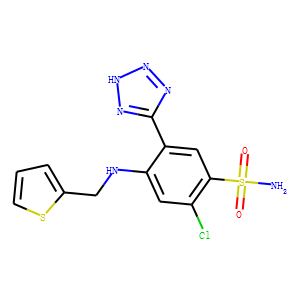| Reference | <div>
<span style="font-family:arial,helvetica,sans-serif;"><span style="font-size:12px;">1. Biopharm Drug Dispos. 2003 Oct;24(7):275-97. doi: 10.1002/bdd.365.Pharmacokinetics and pharmacodynamics of azosemide.Suh OK(1), Kim SH, Lee MG.</span></span></div>
<div>
</div>
<div>
<span style="font-family:arial,helvetica,sans-serif;"><span style="font-size:12px;">Author information:</span></span></div>
<div>
<span style="font-family:arial,helvetica,sans-serif;"><span style="font-size:12px;">(1)College of Pharmacy and Research Institute of Pharmaceutical Sciences, Seoul </span></span></div>
<div>
<span style="font-family:arial,helvetica,sans-serif;"><span style="font-size:12px;">National University, Seoul, Republic of Korea.</span></span></div>
<div>
</div>
<div>
<span style="font-family:arial,helvetica,sans-serif;"><span style="font-size:12px;">Azosemide is used in the treatment of oedematous states and hypertension. The exact mechanism of action is not fully understood, but it mainly acts on both the medullary and cortical segments of the thick ascending limb of the loop of Henle. Delayed tolerance was demonstrated in humans by homeostatic mechanisms (principally an increase in aldosterone secretion and perhaps also an increase in the reabsorption of solute in the proximal tubule). After oral administration to healthy humans in the fasting state, the plasma concentration of azosemide reached its peak at 3-4 h with an absorption lag time of approximately 1 h and a terminal half-life of 2-3 h. The estimated extent of absolute oral </span></span></div>
<div>
<span style="font-family:arial,helvetica,sans-serif;"><span style="font-size:12px;">bioavailability in humans was approximately 20.4%. After oral administration of the same dose of azosemide and furosemide, the diuretic effect was similar between the two drugs, but after intravenous administration, the effect of azosemide was 5.5-8 times greater than that in furosemide. This could be due to the considerable first-pass effect of azosemide. The protein binding to 4% human serum albumin was greater than 95% at azosemide concentrations ranging from 10 to 100 microg/ml using an equilibrium dialysis technique. The poor affinity of human tissues to azosemide was supported by the relatively small value of the apparent post-pseudodistribution volume of distribution (Vdbeta), 0.262 l/kg. </span></span></div>
<div>
<span style="font-family:arial,helvetica,sans-serif;"><span style="font-size:12px;">Eleven metabolites (including degraded products) of azosemide including M1, glucuronide conjugates of both M1 and azosemide, thiophenemethanol, thiophencarboxylic acid and its glycine conjugate were obtained in rats. Only azosemide and its glucuronide were detected in humans. In humans, total body clearance, renal clearance and terminal half-life of azosemide were 112 ml/min, 41.6 ml/min and 2.03 h, respectively. Azosemide is actively secreted in the renal proximal tubule possibly via nonspecific organic acid secretory pathway in humans. Thus, the amount of azosemide that reaches its site of action could be </span></span></div>
<div>
<span style="font-family:arial,helvetica,sans-serif;"><span style="font-size:12px;">significantly modified by changes in the capacity of this transport system. This capacity, in turn, could be predictably changed in disease states, resulting in decreased delivery of the diuretic to the transport site, as well as in the presence of other organic acids such as nonsteroidal anti-inflammatory drugs which could compete for active transport of azosemide. The urinary excretion rate of azosemide could be correlated well to its diuretic effects since the receptors are located in the loop of Henle. The diuretic effects of azosemide were dependent on the rate and composition of fluid replacement in rabbits; therefore, this factor should be considered in the evaluation of bioequivalence </span></span></div>
<div>
<span style="font-family:arial,helvetica,sans-serif;"><span style="font-size:12px;">assessment.</span></span></div>
<div>
</div>
<div>
<span style="font-family:arial,helvetica,sans-serif;"><span style="font-size:12px;">Copyright 2003 John Wiley & Sons, Ltd.</span></span></div>
<div>
</div>
<div>
<span style="font-family:arial,helvetica,sans-serif;"><span style="font-size:12px;">DOI: 10.1002/bdd.365</span></span></div>
<div>
<span style="font-family:arial,helvetica,sans-serif;"><span style="font-size:12px;">PMID: 14520682 [Indexed for MEDLINE]</span></span></div>
<div>
</div>
<div>
</div>
<div>
<span style="font-family:arial,helvetica,sans-serif;"><span style="font-size:12px;">2. J Cardiovasc Pharmacol Ther. 2014 Jan;19(1):5-13. doi: 10.1177/1074248413497257. </span></span></div>
<div>
<span style="font-family:arial,helvetica,sans-serif;"><span style="font-size:12px;">Epub 2013 Nov 15.Diuretics: a review and update.Roush GC(1), Kaur R, Ernst ME.</span></span></div>
<div>
</div>
<div>
<span style="font-family:arial,helvetica,sans-serif;"><span style="font-size:12px;">Author information:</span></span></div>
<div>
<span style="font-family:arial,helvetica,sans-serif;"><span style="font-size:12px;">(1)1UCONN School of Medicine and St Vincent's Medical Center, Bridgeport, CT, </span></span></div>
<div>
<span style="font-family:arial,helvetica,sans-serif;"><span style="font-size:12px;">USA.</span></span></div>
<div>
</div>
<div>
<span style="font-family:arial,helvetica,sans-serif;"><span style="font-size:12px;">Diuretics have been recommended as first-line treatment of hypertension and are also valuable in the management of hypervolemia and electrolyte disorders. This review summarizes the key features of the most commonly used diuretics. We then provide an update of clinical trials for diuretics during the past 5 years. Compared to other classes of medications, thiazide diuretics are at least as effective in reducing cardiovascular events (CVEs) in patients with hypertension and are more effective than β-blockers and angiotensin-converting enzyme inhibitors in reducing stroke. Observational cohort data and a network analysis have shown that CVEs are lowered by one-fifth from chlorthalidone when compared to the commonly used thiazide, hydrochlorothiazide. Relative to placebo, </span></span></div>
<div>
<span style="font-family:arial,helvetica,sans-serif;"><span style="font-size:12px;">chlorthalidone increases life expectancy. In those aged 80 years and older, the diuretic, indapamide, lowers CVEs relative to placebo. The aldosterone antagonist, eplerenone, lowers total mortality in early congestive heart failure. The benefit of eplerenone following acute myocardial infarction (MI) is limited to administration within 3 to 6 days post-MI. Aldosterone antagonists have been shown to lower the incidence of sudden cardiac death and to reduce proteinuria. In the setting of heart failure, long acting loop diuretics azosemide and torasemide are more effective in improving heart failure outcomes </span></span></div>
<div>
<span style="font-family:arial,helvetica,sans-serif;"><span style="font-size:12px;">than the far more commonly used short acting furosemide. Evening dosing of diuretics appears to lower CVEs relative to morning dosing. In conclusion, diuretics are a diverse class of drugs that remain extremely important in the management of hypertension and hypervolemic states.</span></span></div>
<div>
</div>
<div>
<span style="font-family:arial,helvetica,sans-serif;"><span style="font-size:12px;">DOI: 10.1177/1074248413497257</span></span></div>
<div>
<span style="font-family:arial,helvetica,sans-serif;"><span style="font-size:12px;">PMID: 24243991 [Indexed for MEDLINE]</span></span></div>
|

